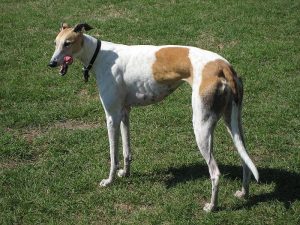Breed History
The Greyhound is a sighthound which has been bred for “coursing” game and racing. The Greyhound has been around since 2900 B.C. This breed  originated in Egypt and carvings of the Greyhound have been found in tombs of ancient Egyptians. They were brought to England by traders before 90 A.D. Greyhounds were introduced to America in the 1500s by Spanish explorers. Their natural quarry are rabbit and hare, although they have been used to hunt larger animals as well. The Greyhound’s speed and keen eyesight helped it to excel at its work. A Greyhound can reach full speed of 43 mph within six strides. The only other animal that can accelerate faster over a short distance is the cheetah. The Greyhound is the only dog mentioned by name in the Bible. The King James version of The Bible, as well as many other versions, name the Greyhound as one of the “four things stately” in the Proverbs.
originated in Egypt and carvings of the Greyhound have been found in tombs of ancient Egyptians. They were brought to England by traders before 90 A.D. Greyhounds were introduced to America in the 1500s by Spanish explorers. Their natural quarry are rabbit and hare, although they have been used to hunt larger animals as well. The Greyhound’s speed and keen eyesight helped it to excel at its work. A Greyhound can reach full speed of 43 mph within six strides. The only other animal that can accelerate faster over a short distance is the cheetah. The Greyhound is the only dog mentioned by name in the Bible. The King James version of The Bible, as well as many other versions, name the Greyhound as one of the “four things stately” in the Proverbs.
Breed Description
Greyhounds are tall and slender. The head is long and narrow with a long muzzle. The ears are small and folded and are semi-perked when the dog is excited. The eyes are dark. The legs are long with the front legs being perfectly straight. The chest is deep and wide. The tail as long and tapers to a slight upward curve. The coat is short and can be found in about thirty recognized colors which include white, brindle, fawn, black, red and blue (gray). These colors can be solid or in a unique combination of colors. Their bone structure is light with a muscular build with a highly flexible spine. They have the largest heart of any breed. They weigh between 60 and 70 pounds and stand 26 to 30 inches high. Greyhounds live 9 to 14 years.
Breed Personality
Although a Greyhound is naturally reserved in nature, they are also brave, intelligent, charming and loving. They can sometimes act reserved towards strangers and possibly even their guardians. The best companions for a Greyhound are singles, active types, families with older children, and people with large yards. Greyhounds are very fast, so it’s best to use a leash when taking them on a walk – otherwise, an unsuspecting squirrel could be their next conquest. This breed needs a lot of attention and companionship in order to stay healthy and happy. They are normally good with children, but you should be careful with rough-house play. For a shyer Greyhound, older children may make better matches. Indoors, a Greyhound is calm and sociable. They develop a strong bond with their family and do not tend to bark much. They are sensitive to the cold, but can do well in a colder climate as long as they wear a coat outside. As would be expected, a Greyhound is happiest within the fold of his “pack.”
Photo: Courtesy of Wikipedia









